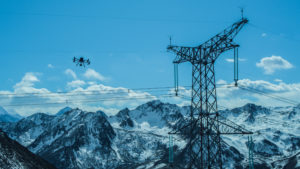
The following is a guest post by Andre Louis-Ferdinand, Head of UAS Technology at Natural Power, an independent consultancy and global service provider for the renewable energy industry. DRONELIFE neither accepts nor makes payment for guest posts.
As we navigate our way through COVID-19 and find new ways of working, I have a new appreciation for our industry and the resiliency it brings to global businesses in a truly global sector.
We remain committed to delivering for our clients across the wind, solar and storage sectors and have been busy developing resourceful solutions to enable our business to continue supporting clients and their assets when travel restrictions have limited site access for key personnel.
In this regard, our drone technology has really come to the fore and increased resiliency in several complex situations for one simple reason – the ability to quickly acquire large amounts of relevant and accurate data. Additionally, local data processing is now so fast, we transmit it straight to the relevant analyst anywhere in the world.
As a renewable energy consultancy, we conduct a wide variety of independent engineering and advisory work as well as delivering due-diligence inspections. During the coronavirus outbreak, we have been busy providing data to multiple departments which has ultimately allowed them to continue operating. Whilst the situation is unsettling and highly disruptive, it has provided the stimulus to the renewables industry to look at deploying drones beyond their current primary use for wind turbine blade inspection.
As travel restrictions continue in many countries and construction sites remain closed, traditional inspection methods have been seriously impacted, but by using drones we have been able to acquire the same information from a safe distance. We recently carried out an independent engineering site visit at a windfarm in Mexico and utilised our drone technology to remotely inspect much of the site which is currently part way through construction. The resulting 3D render of the site has enabled the team to measure distances, area, and even volumetrics. All delivered collaboratively by our in-house advisory team working remotely with the drone flight piloted by myself. In fact, we were also able to review a much larger area, in a fraction of the time, whilst still providing a permanent record for the engineers to reference afterwards. All conducted without the project lead needing to leave his home in Colorado!
Furthermore, we are now developing a variety of other drone services ranging from undertaking solar PV inspections to identifying potential heat losses in district heat networks using infrared cameras. Currently, we evaluate at least 3 “new” uses for UAS technology each week including projects without the deliverable being data. Under internal review are even projects using UAS to string multiple Transmission towers over a 1/3 of a mile apart.
At Natural Power, we operate our own proprietary drone blade inspection software, Ascent. Through an innovative R&D process that took place on three continents (South America, North America and Europe), on hundreds of turbines, and with several O&M partners, we refined the application’s structure and value being offered through exceptional data deliverables. We identified and overcame many challenges in regard to navigation, automated sensor calibration, positioning systems, and computer vision. The findings demonstrate the utility of using a careful and lengthy process to adapt innovative solutions to a global industry problem, particularly the importance of obtaining feedback on the solution from the target users.
We adapted real-time core machine learning technology, onboard obstacle avoidance sensors, RTK (real-time kinematic) positioning projection, and created an extremely scalable drone inspection software suite that can turn an off the shelf commercial DJI aircraft into an automated inspection solution.
The initial theory behind our modest R&D project, was that approaching the problem from a practical perspective, we could create an extremely intelligent software suite that would in effect turn an off the shelf commercial drone into an advanced automated wind turbine blade inspection platform. While this project proved to be harder than initially thought, software combined with a light-industrial commercially available aircraft have successfully created an extremely viable inspection solution.
From start to finish drone technology and services have reached a level where they can support every level of a project, and in these uncertain times, are bringing an essential level of resiliency to our services for the renewable energy sector.
Miriam McNabb is the Editor-in-Chief of DRONELIFE and CEO of JobForDrones, a professional drone services marketplace, and a fascinated observer of the emerging drone industry and the regulatory environment for drones. Miriam has penned over 3,000 articles focused on the commercial drone space and is an international speaker and recognized figure in the industry. Miriam has a degree from the University of Chicago and over 20 years of experience in high tech sales and marketing for new technologies.
For drone industry consulting or writing, Email Miriam.
TWITTER:@spaldingbarker
Subscribe to DroneLife here.